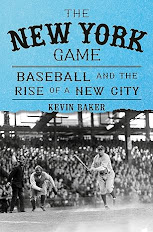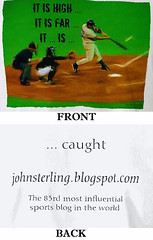The other day, Duque bemoaned the fact that Drew was hitting away into the shift with a man on first, when a bunt may obviously have been called for (Drew being Drew).
Walter, an astute commenter, replied thusly:
And this brings up an amazingly overlooked point about the increased use of statistics in the analysis of baseball, and how they can easily be misused, misconstrued and otherwise mishandled if not in the hands of somebody mathematical who really knows what they're doing. (Not a comment on Walter, but on his sources.)
There is a reason that there is an old saying that there are three kinds of lies--lies, damned lies, and statistics. Statistics are easily misinterpreted and manipulated (I've been in advertising and marketing for almost 40 years, trust me on that last one). Statistics also are not always right because they are not always measuring the specifics of a particular situation.
 Consider the most basic stat: the batting average. If Drew is hitting .190 and is facing a shift because he consistently pulls the ball even with outside pitches, statistically he likely has a less than 19 out of 100 chance of getting a hit. This means that he could not only make an out that leaves the runner at first, but that he could hit into a double play and erase the runner. Whereas, if he can successfully bunt in the opposite direction of the shift, he not only moves the runner into scoring position but has a better than 19/100 chance of reaching base himself. Statistics show that he should bunt in that situation.
Consider the most basic stat: the batting average. If Drew is hitting .190 and is facing a shift because he consistently pulls the ball even with outside pitches, statistically he likely has a less than 19 out of 100 chance of getting a hit. This means that he could not only make an out that leaves the runner at first, but that he could hit into a double play and erase the runner. Whereas, if he can successfully bunt in the opposite direction of the shift, he not only moves the runner into scoring position but has a better than 19/100 chance of reaching base himself. Statistics show that he should bunt in that situation.With runners on first and second, or even with a runner on second with the out, the batter becomes Ellsbury, who has a 28/100 chance of getting a hit overall (although his more recent performance statistics have been worse), which is better than Drew's chances if he does not bunt.
To say that, statistically, the numbers prove that bunting the runner over actually decreases the chance of scoring is not necessarily competent analysis of the statistics, because all situations involving all batters who have sacrifice bunted since the dawn of time contain a variety of irrelevant situations -- including a number of cases where competent hitters bunted and were followed by less competent hitters, a situation that would happen in the old days when bunting the runner over was a chore that fell to some players we would never dream of using for that purpose today. There are other situational considerations that a mathematician baseball fan might be able to point out.
This is the problem with the blanket use of statistics in baseball as "proof" of many things. The best use of statistics is when they are winnowed down to very specific situational subsets that take into account as many details and variables as possible, which, correct me if I'm mistaken, is not the case in the stats Walter is pointing to.
If there is a subset of the bunting stats that's a breakout of sub-.200 pull hitters facing a shift who bunt the other way, and the resulting chances of scoring a run if that bunt is successful when the following hitter(s) is averaging a statistically meaningful number of hits more per at-bats (preferably against the type of pitcher being faced or even against the particular pitcher if there are enough occurrences to be statistically meaningful)...then I think we've really got something.











































